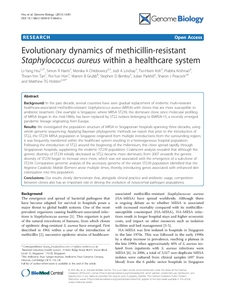Hsu, LY;
Harris, SR;
Chlebowicz, MA;
Lindsay, JA;
Koh, TH;
Krishnan, P;
Tan, TY;
Hon, PY;
Grubb, WB;
Bentley, SD;
et al.
Hsu, LY; Harris, SR; Chlebowicz, MA; Lindsay, JA; Koh, TH; Krishnan, P; Tan, TY; Hon, PY; Grubb, WB; Bentley, SD; Parkhill, J; Peacock, SJ; Holden, MT
(2015)
Evolutionary dynamics of methicillin-resistant Staphylococcus aureus within a healthcare system.
Genome Biology, 16.
p. 81.
ISSN 1474-760X
https://doi.org/10.1186/s13059-015-0643-z
SGUL Authors: Lindsay, Jodi Anne
![[img]](https://openaccess.sgul.ac.uk/107465/1.hassmallThumbnailVersion/Evolutionary%20dynamics%20of%20methicillin-resistant%20Staphylococcus%20aureus%20within%20a%20healthcare%20system..pdf)  Preview |
|
["document_typename_cannot open `/data/SGUL/sgul/eprints3/archives/sgul/documents/disk0/00/10/74/65/01/Evolutionary' (No such file or directory)
cannot open `dynamics' (No such file or directory)
cannot open `of' (No such file or directory)
cannot open `methicillin-resistant" not defined]
Published Version
Available under License Creative Commons Attribution.
Download (1MB)
| Preview
|
Abstract
BACKGROUND: In the past decade, several countries have seen gradual replacement of endemic multi-resistant healthcare-associated methicillin-resistant Staphylococcus aureus (MRSA) with clones that are more susceptible to antibiotic treatment. One example is Singapore, where MRSA ST239, the dominant clone since molecular profiling of MRSA began in the mid-1980s, has been replaced by ST22 isolates belonging to EMRSA-15, a recently emerged pandemic lineage originating from Europe. RESULTS: We investigated the population structure of MRSA in Singaporean hospitals spanning three decades, using whole genome sequencing. Applying Bayesian phylogenetic methods we report that prior to the introduction of ST22, the ST239 MRSA population in Singapore originated from multiple introductions from the surrounding region; it was frequently transferred within the healthcare system resulting in a heterogeneous hospital population. Following the introduction of ST22 around the beginning of the millennium, this clone spread rapidly through Singaporean hospitals, supplanting the endemic ST239 population. Coalescent analysis revealed that although the genetic diversity of ST239 initially decreased as ST22 became more dominant, from 2007 onwards the genetic diversity of ST239 began to increase once more, which was not associated with the emergence of a sub-clone of ST239. Comparative genomic analysis of the accessory genome of the extant ST239 population identified that the Arginine Catabolic Mobile Element arose multiple times, thereby introducing genes associated with enhanced skin colonization into this population. CONCLUSIONS: Our results clearly demonstrate that, alongside clinical practice and antibiotic usage, competition between clones also has an important role in driving the evolution of nosocomial pathogen populations.
| Item Type: |
Article
|
| Additional Information: |
© 2015 Hsu et al.; licensee BioMed Central. This is an Open Access article distributed under the terms of the Creative
Commons Attribution License (http://creativecommons.org/licenses/by/4.0), which permits unrestricted use, distribution, and
reproduction in any medium, provided the original work is properly credited. The Creative Commons Public Domain
Dedication waiver (http://creativecommons.org/publicdomain/zero/1.0/) applies to the data made available in this article,
unless otherwise stated. |
| Keywords: |
Bayes Theorem, Cloning, Molecular, Cross Infection, DNA, Bacterial, Evolution, Molecular, Gene Library, Genetic Loci, Genetics, Population, Genome, Bacterial, Hospitals, Humans, Methicillin-Resistant Staphylococcus aureus, Phylogeny, Phylogeography, Sequence Analysis, DNA, Singapore, Humans, Cross Infection, DNA, Bacterial, Bayes Theorem, Cloning, Molecular, Sequence Analysis, DNA, Genetics, Population, Evolution, Molecular, Phylogeny, Gene Library, Genome, Bacterial, Hospitals, Singapore, Methicillin-Resistant Staphylococcus aureus, Genetic Loci, Phylogeography, Bioinformatics, 05 Environmental Sciences, 06 Biological Sciences, 08 Information And Computing Sciences |
| SGUL Research Institute / Research Centre: |
Academic Structure > Infection and Immunity Research Institute (INII) |
| Journal or Publication Title: |
Genome Biology |
| ISSN: |
1474-760X |
| Language: |
eng |
| Publisher License: |
Creative Commons: Attribution 4.0 |
| Projects: |
|
| PubMed ID: |
25903077 |
| Web of Science ID: |
WOS:000353374900001 |
| Dates: |
| Date |
Event |
| 2015-04-23 |
Published |
|
 |
Go to PubMed abstract |
| URI: |
https://openaccess.sgul.ac.uk/id/eprint/107465 |
| Publisher's version: |
https://doi.org/10.1186/s13059-015-0643-z |
Statistics
Item downloaded times since 14 Jun 2016.
Actions (login required)
 |
Edit Item |



